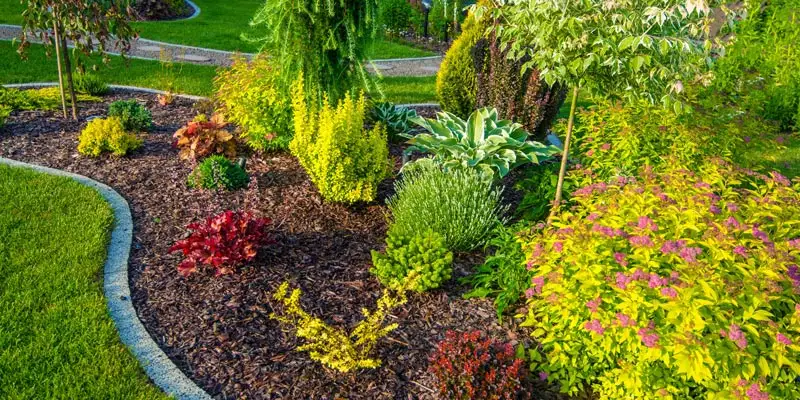7 Simple Techniques For Landscape Design
Table of ContentsWhat Does Landscape Design Mean?Rumored Buzz on Landscape DesignThe Only Guide to Landscape DesignWhat Does Landscape Design Mean?The Ultimate Guide To Landscape Design
Formal style motif. Debt: Gail Hansen, UF/IFAS The yard is an expansion of the home where a variety of tasks take place. A backyard can normally be separated into three locations: public (the front lawn), personal (the garden), and service (commonly the side lawn). The location of task locations depends mainly on the kind of location, the size of space needed, the kind of activity, and the wanted closeness to other tasks and frameworks.The outside wall surface of the house usually works as the initial wall or beginning point of an outside space. Incompatible uses ought to be separated, and relevant tasks, such as cooking and eating, should be created to make the lawn more effective and satisfying. When utilizing hardscape to produce areas, use construction material comparable to that utilized in the home for connection from your home right into the garden.
Linked rooms. Debt: Gail Hansen, UF/IFAS Utilizing comparable hardscape functions and duplicating plants draws the eye around the yard. Important points in the process can be stressed with growings or functions that attract interest and encourage movement in a specific direction. Moving along the course takes a person from one area to the next and allows the user to have a variety of experiences.
Landscape Design Can Be Fun For Everyone

For emotional convenience plants are utilized as physical or implied obstacles for privacy and security. Physical obstacles block both the sight and accessibility to an area and consist of fences, wall surfaces and plant bushes. Implied obstacles, commonly reduced growing plants, block gain access to but not the view (Number 9). Other functions of plants consist of cleaning up the air, stopping disintegration and dirt loss, keeping wetness in the dirt, and returning natural issue to the soil.
Physical and indicated obstacles. Credit Scores: Gail Hansen, UF/IFAS For these reasons, the sorts of plants to be used (such as trees, hedges, or groundcovers) must be chosen in the early stages of preparation (Landscape Design). Plant types are picked for their functional capacities to ensure that their future function and required room can be taken into consideration at the very same time

What Does Landscape Design Do?
Each plant mass is in front of, behind, or alongside, an additional mass. Number 11. Horizontal plant layers. Credit Rating: Gail Hansen, UF/IFAS Number 12. Upright plant layers. Landscape Design. Credit Rating: Gail Hansen, UF/IFAS Duplicating plants within a mass and repeating masses with comparable plants ties the garden together. The specific plant characteristics must be thought about to efficiently layer and mass plants.
All plant make-ups begin with the primary structure plants, the big, primarily evergreen history plants-such as the trees and large shrubs. These plants separate or enframe areas, regulate the dimension of the space, and provide the starting point for selecting the suitable characteristics of the click over here 2nd layer, midground plants, for massing and infill.
Essential points in the garden need to be highlighted by the use of special plants, distinctive structures, or garden ornaments. Marking thresholds or entryways to spaces can be made with entrances, arbors, and actions, or through using distinct and vivid plants. The form and/or design theme of the yard will typically assist identify the crucial points and just how they must be highlighted.
Other important places in the lawn are focal points, which is made use of to visually organize a landscaped area. The sort of centerpiece often depends on the watching point of view. Different viewpoints or viewpoints can reveal different compositions in the landscape that might require a variety of centerpieces. Contrasting appearance, form, size and shade will certainly record and hold the eye.
Fascination About Landscape Design

Plant kinds. Debt: Gail Hansen, UF/IFAS After type, appearance is the next leading feature of a plant; crude, medium and fine structures can be used for comparison and focus in the landscape.
The enjoyable fragrance of plants, the audio of wind in the trees, the audio and appearance of water, and the colors and textures of sculptures, pots and yard furniture all include to the experience of the garden. One detail that is often ignored is the impact of light on the visual appeals of the plants.

Getting The Landscape Design To Work
It is essential to recognize the eventual mature size of plants so they can be placed in the right area and spaced appropriately when they are installed. Providing plants room to grow is a challenge due to the fact that the common mature size is normally based upon optimal growing problems and the environmental problems of a site might trigger a plant Bonuses to grow larger or stay smaller sized.
Comments on “Landscape Design - The Facts”